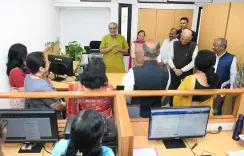How Did India Cements End Up with a Rs 133 Crore Loss in Q1?

Synopsis
Key Takeaways
- India Cements reported a significant loss of Rs 132.90 crore in Q1 FY26.
- Revenue remained flat at Rs 1,024.74 crore.
- Expenses exceeded total revenue, leading to losses.
- Future plans include capital expenditures for efficiency improvements.
- Optimism remains about the company's growth potential.
Mumbai, July 19 (NationPress) India Cements Limited, a subsidiary of UltraTech Cement, reported a net consolidated loss of Rs 132.90 crore in the first quarter of the financial year (Q1 FY26), marking a significant downturn. This is a stark contrast to the net consolidated profit of Rs 58.47 crore recorded in the same quarter last year (Q1 FY25). The previous quarter (Q1 FY25) had seen profits of Rs 14.68 crore, according to their exchange filing.
In terms of revenue, the company's operations remained relatively unchanged at Rs 1,024.74 crore year-on-year, compared to Rs 1,026.76 crore in the same period last year. However, there was a noticeable decline of 14 percent sequentially from Rs 1,197.30 crore in the prior quarter.
The total expenses for the quarter were recorded at Rs 1,042.19 crore, which is slightly lower than the Rs 1,190.24 crore incurred in Q1 FY25, according to the filing.
Despite the decrease in expenses, they exceeded the total revenue (operational revenue plus other income) of Rs 1,033.85 crore, resulting in losses for the cement manufacturer.
The Profit After Tax (PAT) before accounting for one-time exceptional items was a negative Rs 9.13 crore, a slight improvement compared to the negative Rs 182.21 crore posted in the same quarter last year, as indicated in the filing.
UltraTech has since acquired the promoter's stake in the south India-based cement firm, making it a fully owned subsidiary as of December 24, 2024.
Looking ahead, the company plans to undertake a capital expenditure program over the next two years aimed at enhancing efficiency, reducing operating costs, increasing the use of renewable energy, and improving safety standards, as mentioned in their filing.
Regarding future prospects, India Cements expressed confidence in its potential for growth.
In the last quarter, the company recorded a 3.11 percent annual decline in revenue, totaling Rs 1,197.3 crore.









